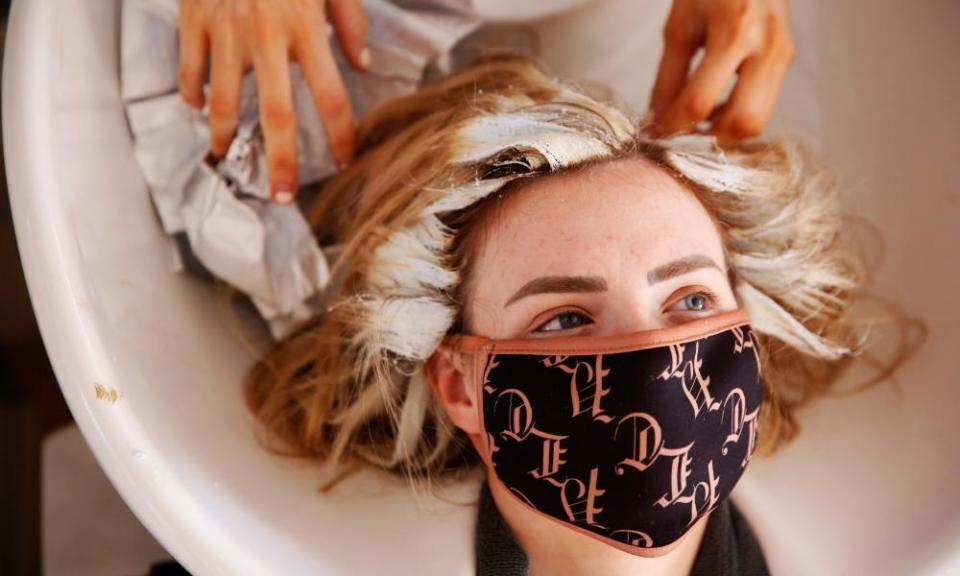Hairdressers in England face ‘stampede’ for post-lockdown appointments

There has inevitably, noted Josh Wood, the hair colour expert and founder of a leading west London salon, been “a stampede beyond belief” for appointments.
More than three months after Britain entered another strict lockdown, the gradual process of easing restrictions will reach hairdressers in England next week, and for many – battling with bouffants, man buns, dark roots and chin-fringes – their reopening cannot come soon enough. With hairdressers in Wales and Scotland having recently reopened, it has been the turn of English clients to rush breathlessly to pre-book appointments. (The Northern Irish must wait for now.)
But while some are desperate for a professional to rescue their hair, for others the months deprived of grooming have created an opportunity to think differently about hair and self-image. There are many lockdown outcomes that are more important than the temporary closure of salon services. And yet, said Wood, who is also the founder of an eponymous range of home hair dyes, the fact that we have all had to deal with our natural, untamed hair is significant in its own way.
With the closure of barbers and hairdressing salons, “something was taken away that had been taken for granted,” he said. “And that made people question: did they want their hair like that? Did they want that kind of high consumerism? I think this has really given us a time to pause. There’s a rethink about how people want to look, how they want to spend their time, how they want to spend their money. It’s a real reflection moment to me.”
Mikaela Loach, a medical student and climate justice activist at the University of Edinburgh, would agree. Having permed her afro hair and worn extensions for much of her life, she first embarked on lockdown with her hair in braids, and continued to keep them in, even after they became messy. “I was always scared of having to look after my actual hair as it grew out of my head,” she said.
Finally removing them to discover her natural hair was “a really nice journey [of] self-acceptance and love,” she said, particularly as she realised she didn’t need to invest in dozens of products, let alone the £100 she was spending every six weeks to maintain her braids.
“Being stuck at home and not seeing people, a lot of us were confronted with who we are and what we actually looked like,” she said. That can require vulnerability, she added, “but actually, the way that our hair grows out of our heads – there is nothing wrong with that”.
Helen Goodhand, a teacher from Sheffield, said she may abandon the professionals altogether, having discovered that her husband, Nick (“he’s a mechanical engineer, not a hairdresser”), was as skilled at bleaching her pixie cut as with clippers.
She said: “If it went horribly wrong, then obviously you can go back to the hairdresser’s. But I think lockdown has taught people to be more resourceful. I’ve spent a lot of money over the years getting my hair done, and I don’t know now whether I feel like it’s a bit indulgent.”
During the first pandemic, Lisa Simpson, an administrator and stay-at-home mum from Leeds, did all she could to maintain her mid-brown hair from home, including asking her hair colourist to leave a pot of dye on her doorstep. This time around, she has been letting her grey roots grow out, with the encouragement of a supportive online community of women who are also embracing their true colours.
“I don’t know why, but it just didn’t seem as important this time round,” said Simpson. “Maybe I’ve relaxed into it a little bit more. And when I look back on pictures from last year, when my hair was fully done, I don’t actually think the colour suits me as much as the grey and white. I’ve been fighting that thing for so long.”
She does not want to abandon professional help, however – instead, with the hundreds of pounds she has already saved, Simpson has booked into an expensive salon where she hopes a colour expert will help make the transition to grey easier.
Has Covid stripped us of our vanity and desire for artifice? Julia Twigg, emeritus professor of social policy and sociology at the University of Kent, isn’t convinced. “This is an interesting moment, but whether it will last is another thing,” said Twigg, who has conducted research into hair, fashion and ageing.
Part of the enduring pressure to disguise or combat signs of ageing comes from “the enormous consumption culture that has developed around that”, she noted. “Like all Covid changes, we simply don’t know whether we will snap back into old patterns. There will be long term changes, but not all of them [will stick].”
For now, Wood predicts many clients will opt to visit salons less frequently, maintaining dyed hairstyles at home and visiting their colourists only a few times a year for expert input – “and that’s a completely new category to the industry”, she said.
Andreas Wild, a leading stylist based at the Notting Hill salon Larry King, said even those who are desperate to secure an appointment are considering a change. He has noticed male clients wanting to move away from short back and sides into longer styles, and women embracing fringes, asymmetric cuts or unusual colours that say: “I want to make a statement when I am seen again.”
“It’s about standing out,” said Wild. “At the end of the day, we have all been through this. Let’s do something completely different.”

